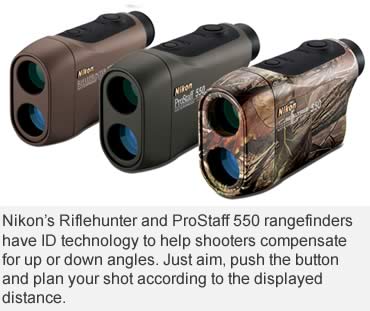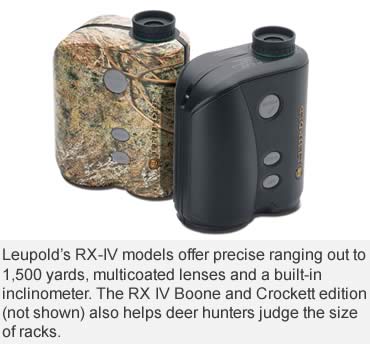How laser units work, and why they’ve become indispensable to modern hunters.
It was really, really cold out. So cold, the fabric of my daypack froze like a potato chip. So cold, the soda pop in the plastic bottle inside my daypack turned to slush. So when I looked out into the cornfield about 3 p.m. and saw the big white-tailed buck scraping kernels off the cobs as fast as his lips would work, two thoughts instantly crossed my mind: That’s a shooter; and I hope my stuff will work in this miserable weather.
The first thing I did was reach for my laser rangefinder. I was carrying a compact model around my neck, where it had been exposed to the elements for hours. When I hit the button, the unit fired right up and the screen told me 125 yards — just inside the distance I was comfortable shooting the .45-caliber muzzleloader.
Resting the barrel on a tree limb, I cranked the scope up to 9x, placed the crosshairs on the buck and waited for his chest to clear the cornstalks. When the smoke cleared, I saw the deer tumble head over petunias. Later, the big 9-pointer scored more than 150 inches.
Why Laser Rangefinders?
I hate to admit this, but it’s true. From time to time, I’ve missed shots at game. Sometimes it’s been because my mechanics were all wrong. On a few occasions, buck fever has been the culprit. I’ve also occasionally had rifle or scope malfunctions. But more often than not, the reason I missed was simply misjudging the distance to the target.
Admittedly, I’ve missed more when bowhunting than when shooting a centerfire rifle or inline muzzleloader. But then, regardless of what I chose to hunt with, there came a time when the misses became about as rare as a four-leaf clover. That was when the modern laser rangefinders became available. I’ve grown to love them so much that I never go hunting without one.
Coincidence Rangefinders
There are two basic kinds of rangefinders: coincidence and laser. Coincidence units were the first models available to the general public. They were introduced to hunters and popularized by Ranging Inc. back in the 1980s. The technology was not new, however. In World War II, tanks often carried coincidence-type rangefinders to help in sighting their cannons.
Coincidence rangefinders work on the principle of triangulation. They have two windows and a system of prisms and lenses that produce two images you see when you look through the viewfinder with one eye. You simply turn a pre-calibrated dial, stopping when the two images coincide to become one, and then read the distance on the dial.
The old Ranging 80/2 was a favorite of bowhunters. Later, the company offered the Ranging Range-matic 1000, Ranging 400 and Ranging 200. These were claimed to be accurate between 50 and 1000, 20 and 400, and 16 and 200 yards, respectively.
 Although the Ranging units were reasonably rugged, you had to calibrate them yourself, and learning to use them was quite interesting. In fact, obtaining a truly accurate reading with one, especially at extended distances, was all but impossible. Then, just when I was about to give up on rangefinders, along came the laser models, and everything changed.
Although the Ranging units were reasonably rugged, you had to calibrate them yourself, and learning to use them was quite interesting. In fact, obtaining a truly accurate reading with one, especially at extended distances, was all but impossible. Then, just when I was about to give up on rangefinders, along came the laser models, and everything changed.
Laser Rangefinders
Today, the laser rangefinder is the way to go. The word laser actually stands for “Light Amplification by Stimulated Emission of Radiation.” It is a form of electromagnetic radiation, the same as radio waves and microwaves.
Laser radiation has a much higher frequency than radio waves or microwaves, though.
It’s completely eye safe, meeting FDA Class 1 specifications, and about 1/20 of the light power of a typical TV remote control.
Laser units function by measuring the time it takes a laser pulse to travel to the target and back with a precise, crystal-controlled time base. Based on the speed of light, the unit then calculates the distance traveled. To increase accuracy, the laser measures as many as 60 pulses. Sophisticated error-trapping algorithms help ensure a reliable reading.
The best modern laser rangefinders are precise to within plus or minus 1 yard from bowhunting close to “way out there.” They’re compact, can be comfortably worn around the neck with a strap, or carried in a soft belt pouch. They work on a standard 9-volt or small lithium camera battery and will give thousands of readings before the batteries drain. They can also take a fair amount of field abuse and keep on ticking.
Laser Rangefinder Features
My first experience with a laser rangefinder was on a spring muskox hunt in the Northwest Territories. Though it was late March, it was never any warmer than minus 30 degrees Fahrenheit. The wind was howling, blowing snow and ice sideways. And yet the old Brunton Laser 70 rangefinder repeatedly did its job, helping me take a record-book bull at 30 yards. The unit was accurate from 5 to 70 yards, weighed about 9 3/4 ounces, and measured just 1 7/8 by 4 1/4 by 5 inches.
 Since that hunt, I’ve taken many different rangefinders afield, including models from Bushnell, Leica, Leupold, Nikon, Opti-Logic and Swarovski, and found them literally indispensable.
Since that hunt, I’ve taken many different rangefinders afield, including models from Bushnell, Leica, Leupold, Nikon, Opti-Logic and Swarovski, and found them literally indispensable.
Look through any large mail-order catalog, go to the company websites or visit your local hunting shop to compare the different units. Each make and model will have a little something to make it different from the rest. Still, there are a couple of features the serious hunter should demand.
The first is ruggedness. The better units are housed in an impact-resistant plastic case that also has a rubberized coating to protect its electronics and optics from the bumps and bruises it will get in the woods. I also want a rangefinder to be waterproof and fogproof. I’ve found that waterproof is a relative term, meaning that if it’s pouring rain, I don’t leave my unit unprotected. Using it in a light mist is fine, though. Never let one become submerged.
Those who hunt from treestands or in steep terrain should also consider a rangefinder with an angle-compensation feature. Two examples are the Nikon Archer’s Choice Laser Rangefinder and Nikon RifleHunter 550 Laser Rangefinder. Both are new for 2008 and compensate for various up or down shooting angles. You simply aim, push the button and plan your shot according to the displayed distance. Only one number is displayed — the correct distance needed to make the shot. Both units feature Nikon’s superb multicoated optics.
Two other companies offering similar performance are Bushnell’s ARC (Angle Range Compensation) program and Leupold’s True Ballistic Range system. I’ve found both to work quite well.
Of course, price is always a consideration. A rangefinder can set you back anywhere from a couple hundred bucks to nearly a grand. I’ve used the cheapest to the most expensive models and found those in the $250-$500 class all the rangefinder I needed for serious hunting anywhere in the world.
Don’t Leave Home without One
There are times in the field when things happen quickly and there won’t be time to use a rangefinder. That’s why I still practice estimating distance with my naked eye. Still, I make it a practice now to carry a rangefinder on all my hunts.
While all models come with a neck strap, I’ve taken to wearing mine around my neck with either a Crooked Horn Outfitters’ Slide & Flex Bino system, or by replacing the manufacturer’s strap with a piece of 500-pound test parachute cord. I cut the cord long enough so I can wear the rangefinder over my neck and around one arm bandolero-style. Both methods give me instant access to the unit and keep it from swinging in my way while hiking or climbing. In more static hunting situations, I may use a belt pouch. I always have a spare battery in my daypack in case I run out of power at the wrong time.
In the movie “Magnum Force,” Clint Eastwood’s Harry Callahan character said, “A man’s got to know his limitations.” I do. While I still work hard at being able to eyeball distances, I use my laser rangefinder whenever possible. With today’s reasonably priced, high-quality units, there’s no reason for risking being wrong.
Tricks and Tips
Weather — Rain, dust and high humidity will limit ranging capabilities.
Lighting — Low light gives the best ranging conditions.
Size Matters — The bigger the target, the better chance of an accurate reading.
Target Reflectivity — Bright targets give easier readings; dark objects range poorly.
Target Surface — Flat, smooth, bright surfaces range much easier than a buck’s ribcage.
Angle — The closer you are to reflecting the laser off the target at a 90-degree angle, the farther you can accurately range it.
Waterproof? Don’t believe it! Some units claimed to be waterproof are highly water resistant but can fail in a pouring rain or when submerged. Smart hunters keep their rangefinders as dry as possible.
Steadiness — Take a laser pen pointer and try to hold it steady while aiming at a distant object. You’ll be surprised at how shaky you are. The laser rangefinder is the same way. It illuminates a bigger spot than the pen pointer, but when you’re ranging an object at 1,000 feet or farther, it doesn’t take much movement to have the laser reading a different target. Take a steady rest whenever possible.
Batteries — Always keep batteries in the unit so you don’t forget to install them before heading afield. However, I always reverse my batteries to prevent them from being accidentally drained if the power switch is inadvertently turned on in my pack or at home. And I always have a spare set of batteries in my hunting pack, just in case.
This article was published in the August 2008 edition of Buckmasters GunHunter Magazine. Subscribe today to have GunHunter delivered to your home.